King Clematis Ville de Lyon - features of cultivation and care
Clematis Ville de Lyon is a flowering liana-like shrub that attracts many of both amateur gardeners and professional landscape designers with its appearance. With proper care and minimal efforts to provide it, it is able to delight its owners with magnificent large flowers for many years.
- Description
- Landing features
- Site selection and preparation
- Preparation of planting material
- Landing technology
- Care
- Watering
- Top dressing
- Mulching and loosening
- Pruning
- Preparing for winter
- Reproduction
- Seeds
- Cuttings
- Layers
- By dividing the mother bush
- Diseases and pests
- Examples in landscape design
- Testimonials
- Useful videos
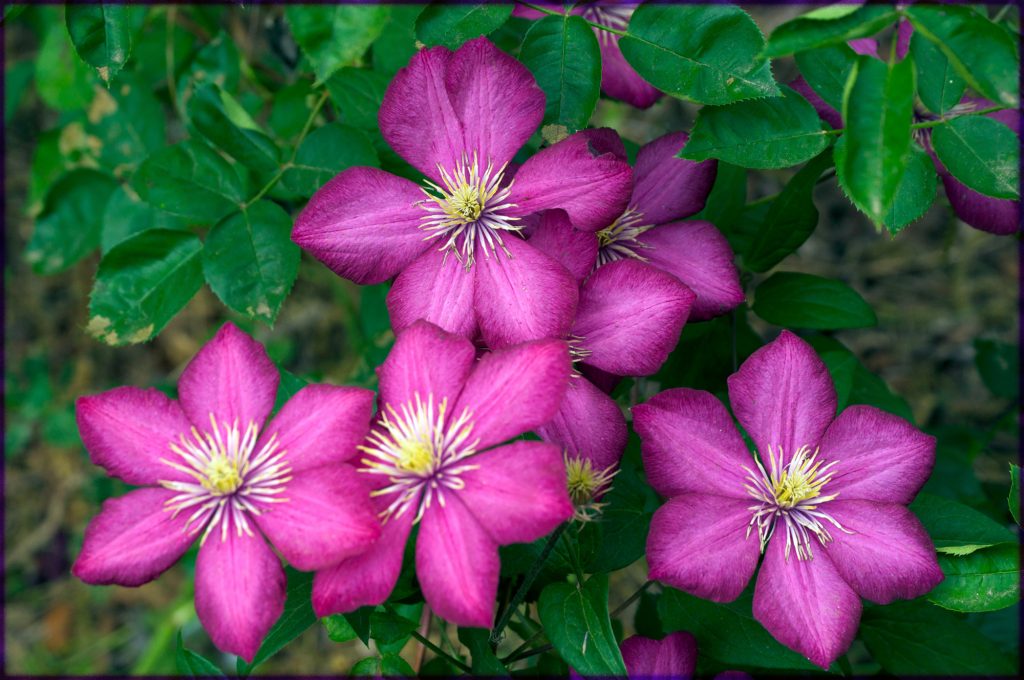
Clematis ville de lyon description
Description
The privateer Ville de Lyon is one of the most popular Clematis varieties cultivated all over the world. On one shrub, up to 15 shoots are formed with a pale brown bark, which becomes brown as it matures.
In length, the processes can reach 3-4 m.At the same time, they are characterized by rather active growth - per day the young growth is 10 cm.
On each branch of the liana, about 15 large flowers with a diameter of 12-15 cm, sometimes 20 cm are formed. The buds consist of 5-7 simple petals. In the center, they are painted in carmine red, along the contour, the shade changes to purple. The stamens are pale yellow.
With excessive illumination, the inflorescences fade to light pink or almost white.
The leaves are small, heart-shaped. Due to the fact that the vine does not cling to the support with the branches, they act as a device for conquering the adjacent territory.
The root system is powerful; in an adult plant, it can weigh up to 5 kg. It is represented by a shortened main root with many thin minor ones.
The flowering period is 3 years from the moment the seedling is planted in a permanent place and lasts from July to September.
Among the advantages of culture are:
- resistance to fungal diseases;
- minimum care requirements;
- high rates of frost resistance;
- the ability to create a beautiful hedge every year;
- profuse long flowering.
Landing features
It is possible to get a healthy and profusely flowering shrub only if it is correctly located on a personal plot.
If all standards are observed, the risk of damage to seedlings, especially sensitive to diseases, is minimized.
The timing of planting large-flowered clematis directly depends on the state of the root system. If it is a closed type and the plant is in a container, then there are no restrictions on this criterion, with the exception of winter.
A shrub with open roots can be planted in a flower bed both in autumn and spring, in warm weather with a stable temperature. The optimal months for the event are September, October.
Site selection and preparation
There are a number of nuances to consider when choosing a location for Ville De Lyon.
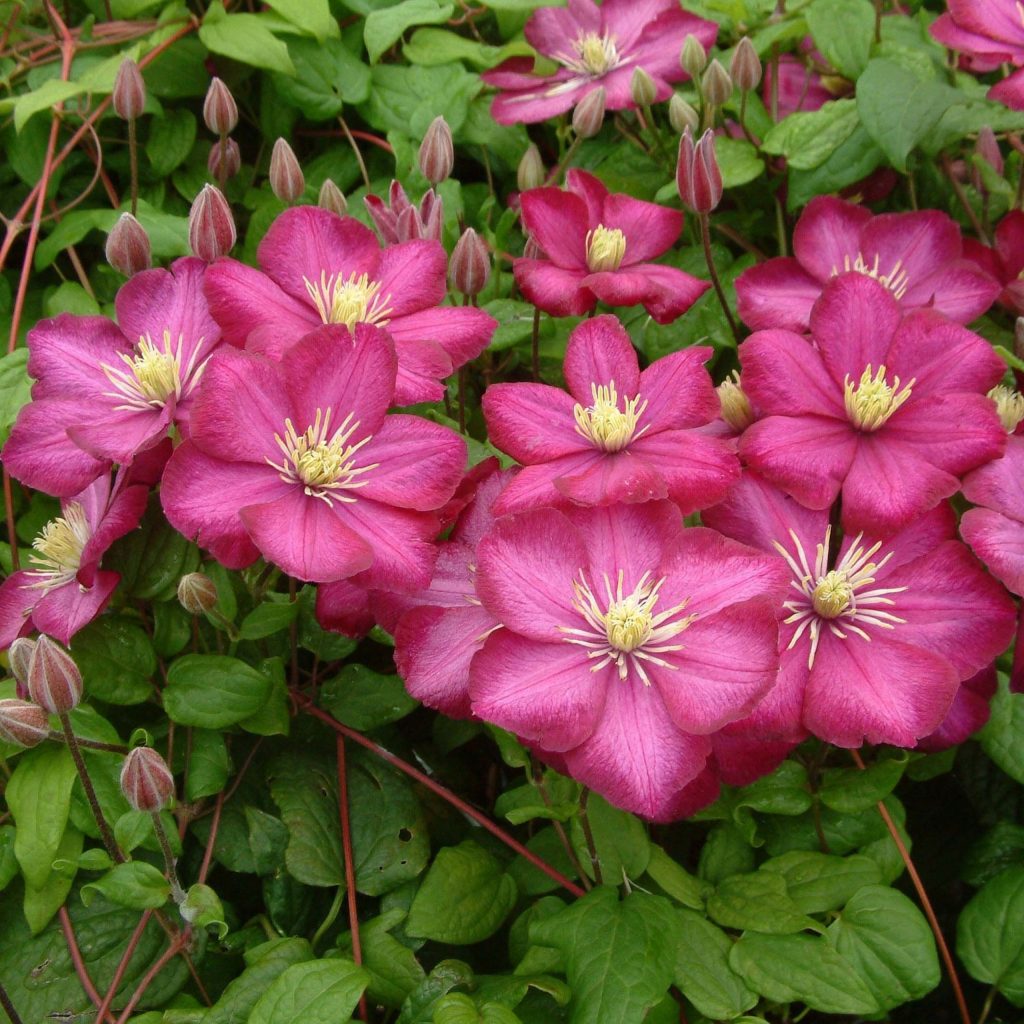
Clematis ville de lyon trimming group
- Culture is photophilous, so the site for it should be well lit.However, under prolonged exposure to direct sunlight, the flowers fade, which significantly reduces the decorative effect of the shrub.
- Vine roots need shading. Ensuring this requirement, it is necessary to understand that constant stagnation of moisture has a detrimental effect on the underground part of the plant and leads to rot damage. Ideally, the site should be on a relative elevation with deep groundwater. If there is no such area in the garden, the soil level is artificially raised and a good drainage layer is made.
- Flowers and strong drafts are afraid. Therefore, open areas for cultivation are not suitable. A prerequisite for the comfortable growth of Clematis is the presence of a shelter in the immediate vicinity - a fence or any other building.
- The soil should be fertile, preferably loamy with a slightly alkaline or neutral environment.
Preparation of planting material
For planting, it is recommended to take seedlings with a strong root system that have reached 2 years of age.
Before the procedure, open roots are examined - if necessary, dry segments are trimmed. After that, the damaged parts are placed for a couple of hours in a solution of potassium permanganate and planted in the ground.
Landing technology
To begin with, dig a hole 0.6 * 0.6 * 0.6 m in size.When placing a group of plants, maintain a distance of at least 1 m.
Then:
- Drainage is laid out from chipped bricks, crushed stone, gravel. The recommended thickness is 15-20 cm.
- Fill the depression ½ with fertile soil, to which 400 g of wood ash, 1 bucket of humus and 50 g of superphosphate are previously added. If necessary, add 150 g of lime to reduce acidity.
- The support is installed, then the seedling. It is positioned so that the lower kidney is 8 cm below the ground level, but is not covered with soil. As a result, a bowl-shaped depression should remain, which should be gradually filled up during the season.
- The surface is tamped, watered abundantly. Sprinkle on top with a layer of mulch.
Care
Watering
In a temperate climate, Clematis is rarely watered, but abundantly. The bush is irrigated with 3 buckets of water per week. In hot weather, the procedure is carried out more often. In this case, care should be taken that the soil does not become waterlogged, and the top layer has time to dry out.
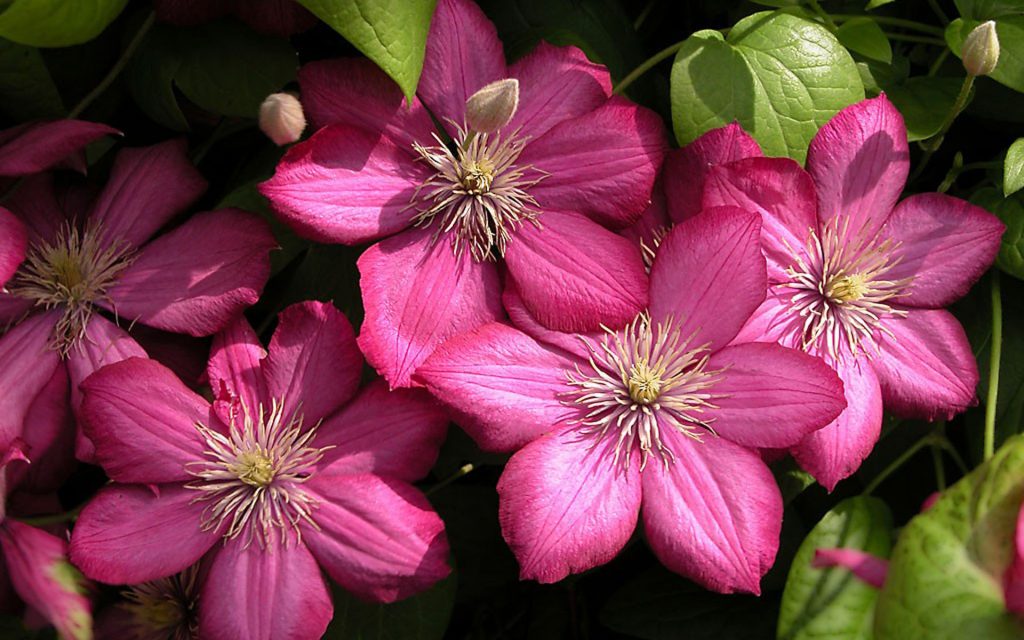
Ville de lion clematis reviews
Top dressing
The guarantee of abundant flowering of the culture is timely feeding. They are made several times during the season:
- In the spring. The plant is watered with milk of lime at the rate of 200 g of lime per 10 liters of water.
- In summer. At the stage of active vegetation, they are fertilized with nitrogen preparations, during the budding period - with mineral complexes.
- In the autumn. Wood ash and plant humus are introduced under the root.
Mulching and loosening
Loosening the soil allows it to saturate with oxygen and prevents the active growth of weeds. The procedure is done regularly in the absence of mulch in the near-stem space.
In addition to protective properties, the layer maintains the moisture content of the substrate at the required level and prevents it from freezing in winter. Sawdust, spruce needles, crushed bark are used as a covering material.
Pruning
Ville De Lyon belongs to the 3rd pruning group. The procedure is carried out in the fall - the shoots of the plant are almost completely cut off, while leaving the 3 lower growth nodes intact. The maximum permissible length after cutting is 20 cm.
In the spring, when the branches begin to actively sprout, they make a sanitary correction, during which all dry and damaged segments are removed.
Preparing for winter
In addition to pruning, on the eve of cold weather, the bushes are sprinkled, sprinkled with humus and fallen leaves. In regions with a harsh climate, a more serious shelter is made.
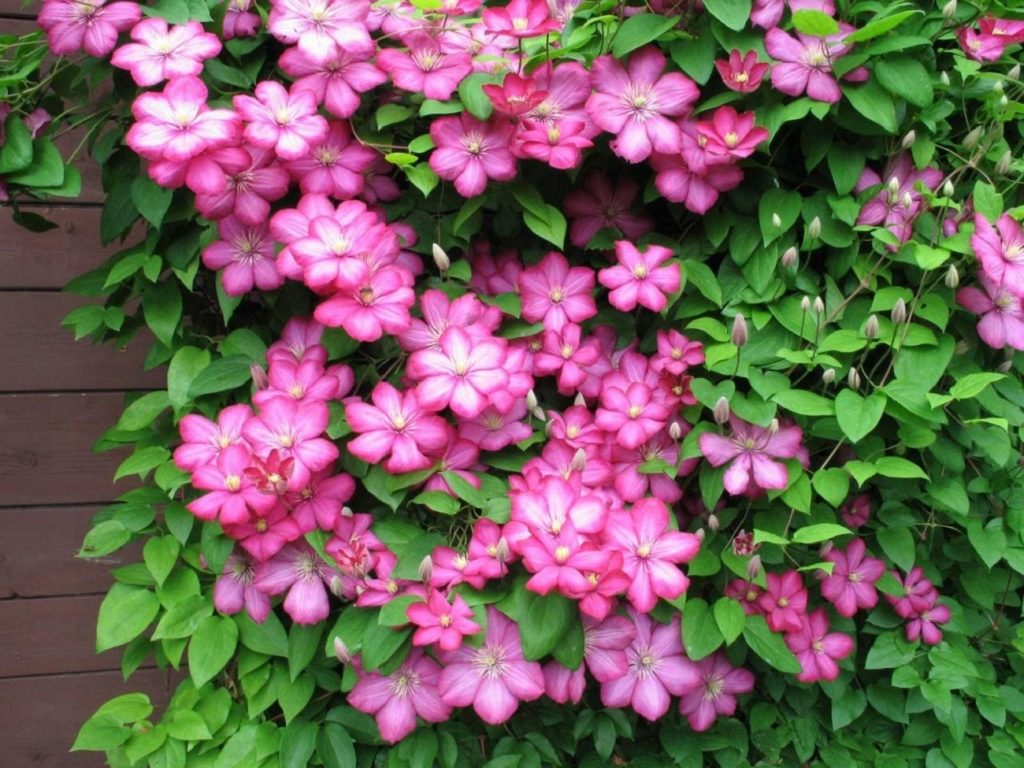
Clematis ville de lyon reviews
If the area in winter is characterized by subzero temperatures (below 25 ° C), the plant is covered according to the following scheme:
- An inverted wooden box is placed on the shortened shoots.
- Spruce branches are laid on top.
- Insulate with burlap.
- If there is a small amount of precipitation in winter, cover the shelter with snow with your own hands.
Reproduction
Seeds
A rather laborious and time-consuming method, extremely rarely used by amateur gardeners. Clematis seeds are characterized by poor and uneven germination, their germination can last up to 8 months. The event should be held immediately after collecting the material.
Growing technology:
- The seeds are kept for about 30 minutes in a solution of Epin or succinic acid. To improve germination, they are preliminarily subjected to stratification.
- Drainage is distributed at the bottom of a low container, a mixture of garden soil, peat, river sand is poured on top.
- Furrows are formed, seeds are laid in them to a depth of no more than 1.5 cm. Sprinkle with a substrate. Moisten with a spray bottle.
- The container is placed in a warm room with diffused light. After 3-4 weeks, the first shoots appear.
- When 2-3 true leaves appear, the seedlings are seated in separate containers.
Cuttings
Propagate the variety by cuttings preferably in the summer. The shoots are taken from a bush that has been growing in one place for at least 3 years, while cutting off no more than ⅓ of the entire length of the lash.
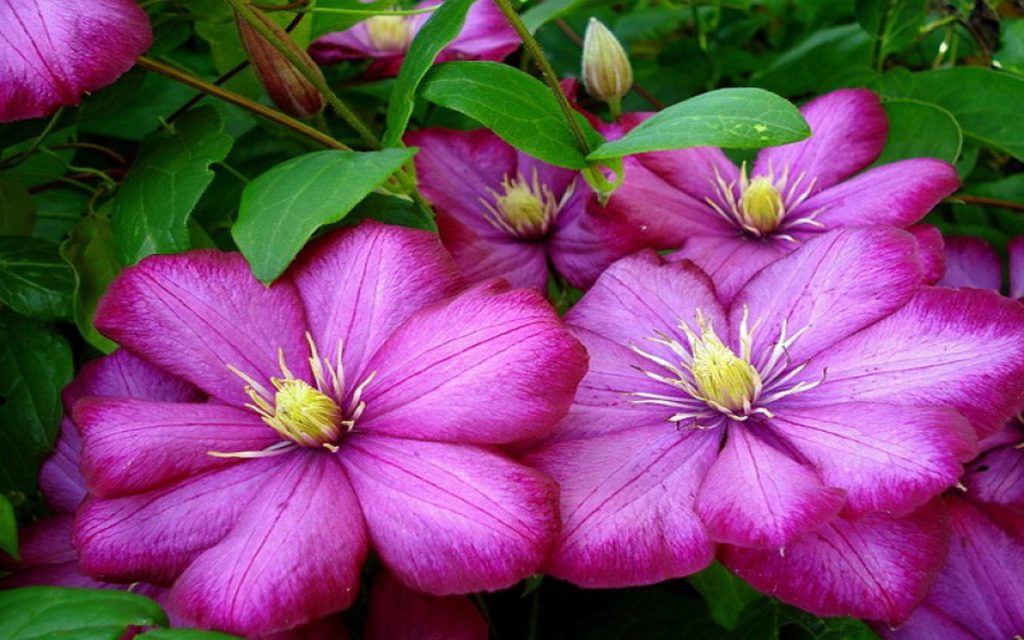
Clematis ville de lyon photos
The readiness of the shoot for reproduction can be judged by its state - it should not break during transformation. It is also better if there are no flowers on the branch.
The cut is treated with a growth stimulator, after which it is stuck into the substrate at an angle. The latter is made two-level: the lower layer consists of river sand and humus in equal proportions, the upper one is represented by perlite.
Subsequently, they are placed in a greenhouse or covered with a film, maintaining high humidity and a temperature of about 22-25 degrees in the containers. After 5-6 weeks, the first leaves appear on the cuttings, which indicates the correct rooting procedure.
Layers
To obtain layering, a hole 10 cm deep is dug near the bush, into which the shoot is bent and sprinkled with earth. Further care is carried out according to the standard scheme.
When young growth appears, the plant is separated from the mother and moved to a new place.
By dividing the mother bush
Reproduction of Clematis by dividing the rhizome is one of the most popular and productive breeding methods. During the procedure, an adult plant is undermined on one side, part of the rhizome is chopped off with a shovel and transplanted.
Diseases and pests
| Name | Symptoms | Prophylaxis | Treatment |
| Fusarium | Brown border along the contour of the leaves, eventually expands towards the center. Affected leaves and apical shoots dry out. | They are regularly fed with phosphorus-potassium preparations, refrain from introducing aggressive organic matter. Watered at the root with a solution of potassium permanganate with the addition of boric acid 1 time per season. They do regular cleaning of weeds, loosen the soil. | Carry out radical pruning to the base. They are treated with special preparations: Agat-25K, Baktofit, Trichodermin, Vitaros, Potassium humate. |
| Powdery mildew | White powdery bloom on all parts of the plant, as the disease progresses, brown spots appear, the leaves dry and fall off. | Avoid overcrowding of plantings and the introduction of a large amount of nitrogen fertilizers, promptly remove plant waste. Spray with a solution of mustard (2 tablespoons of powder per 10 liters of liquid). | Folk methods: ash or iodine solution, milk whey. Purchased funds: Fitosporin-M, Fundazol, Topaz, Baktofit. |
| Wilt | Rapid color change to a brown shade, drying of shoots (most often young shoots are affected) | They do the site cleaning and sanitary pruning in a timely manner, avoid excessive drying out of the soil, periodically spray them with fungicides. | The affected parts are removed, in a critical situation, the plant is completely dug up and burned. They are treated with drugs: Quadris, Fitosporin-M, Quadris, Previkur, Maxim, KS. |
| Nematode | The leaves become smaller, turn yellow, the buds are deformed. Convex neoplasms appear on the roots. | Marigolds, calendula, rudbeckia are planted nearby. | Purchased drugs: Chloropicrin, Nematofagin BT, Basamil, Narcissus, Fitochit, Metarizin. |
| Butterflies and moths | Leaf plates dry, die off. Small holes appear on the surface. | Install sticky traps. | The larvae are harvested by hand, sprayed with insecticides: Karbofos, Zolon, Perinex 40, Rogor. |
| Snails and slugs | Eaten buds and leaves, large holes on the surface. | Sprinkle the soil with salt, mustard, crushed egg shells. | Traditional methods: garlic infusion, ammonia solution (1: 6), coffee. Purchased funds: Thunder, Mata, Ulicid. |
| Aphid | Sticky smudges, deformed leaves. | They destroy anthills, maintain the cleanliness of the site. | Traditional methods: dusting with ash, shampoo for animals, soapy water. Systemic drugs: Aktara, Tanrek, Iskra Zolotaya, monsoon, Respect, Tabu. |
| Spider mite | Small punctures, white spider web. | Sprinkle with infusion of garlic. | Insecticides: Fitoverm, Akarin, Anti-mite, Bitoxibacillin. |
Examples in landscape design
In landscape gardening, Ville De Lyon is in high demand. The flower is used in several variations:
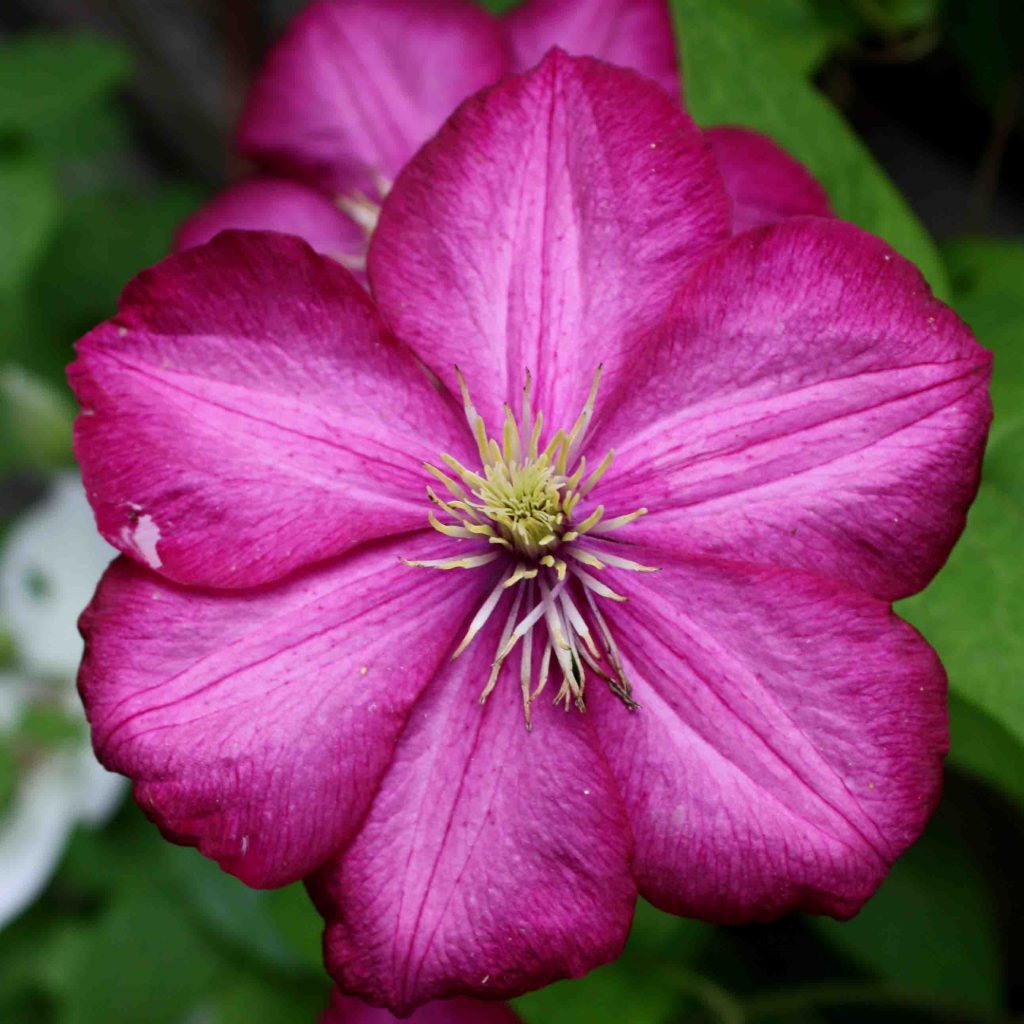
Ville de lion clematis photos
- Single landing at the porch or gazebo entrance.
- As a decoration for an arch or column.
- Near conifers, where large-flowered Clematis looks advantageous against the background of rich greenery.
Testimonials
Gardeners have a positive opinion of the Ville De Lyon variety, they note the unpretentiousness of the shrub, the ability to tolerate frost in winter without loss and excellent decorative qualities. Among the minuses, it is noted that the culture forms buds relatively late, and for uniformity of flowering, it is necessary to set the direction of the shoots at the initial stage of the growing season.

